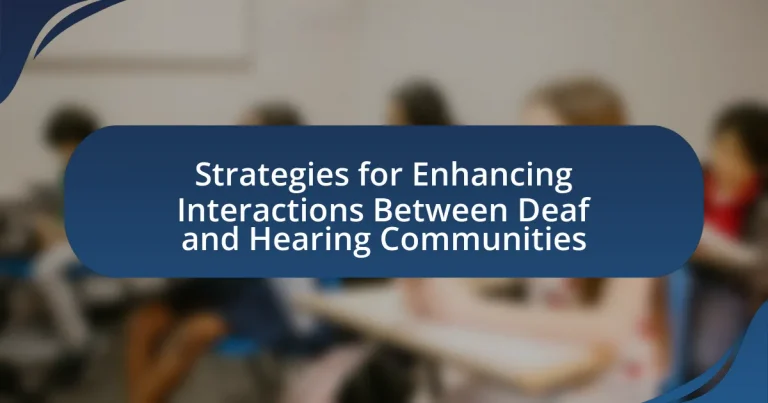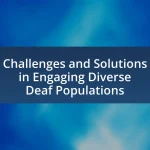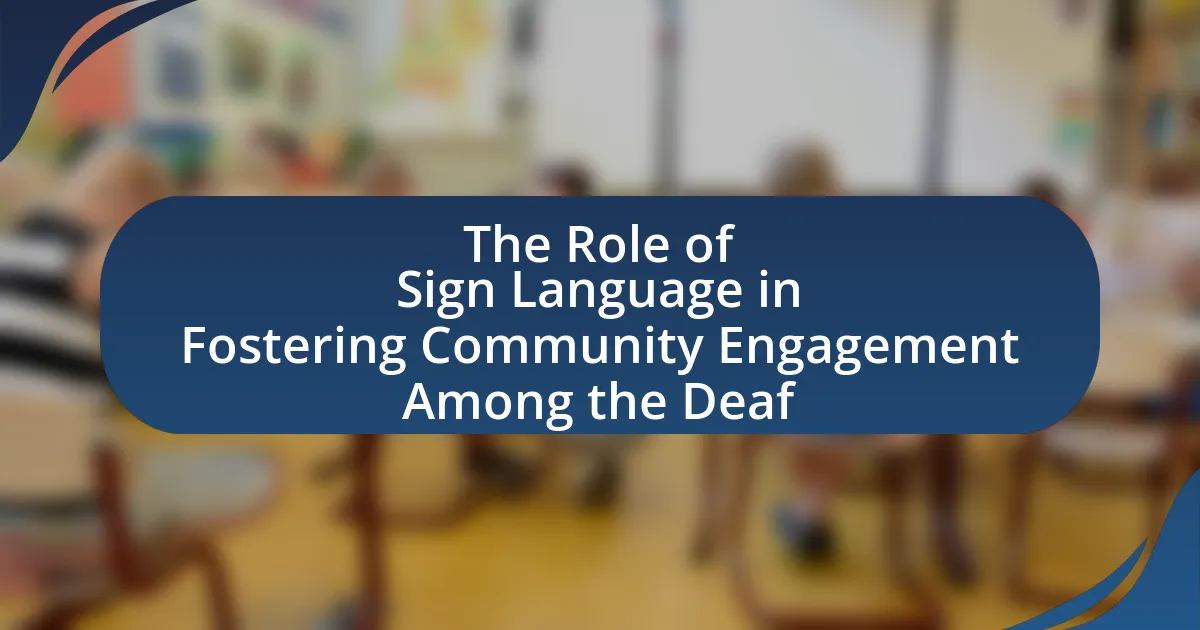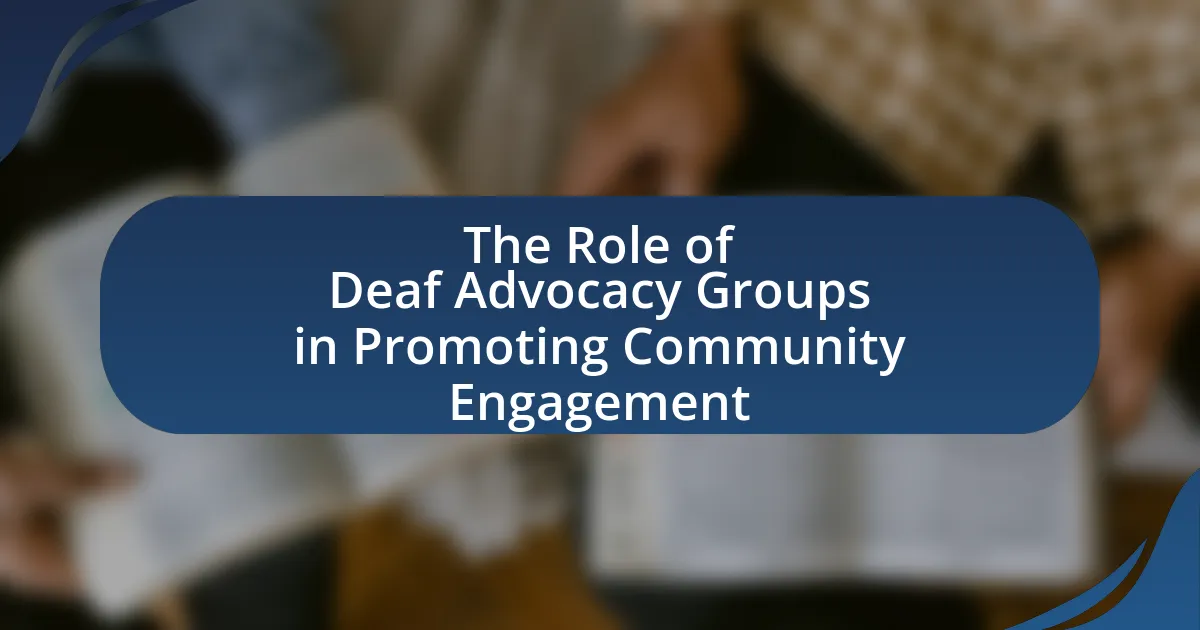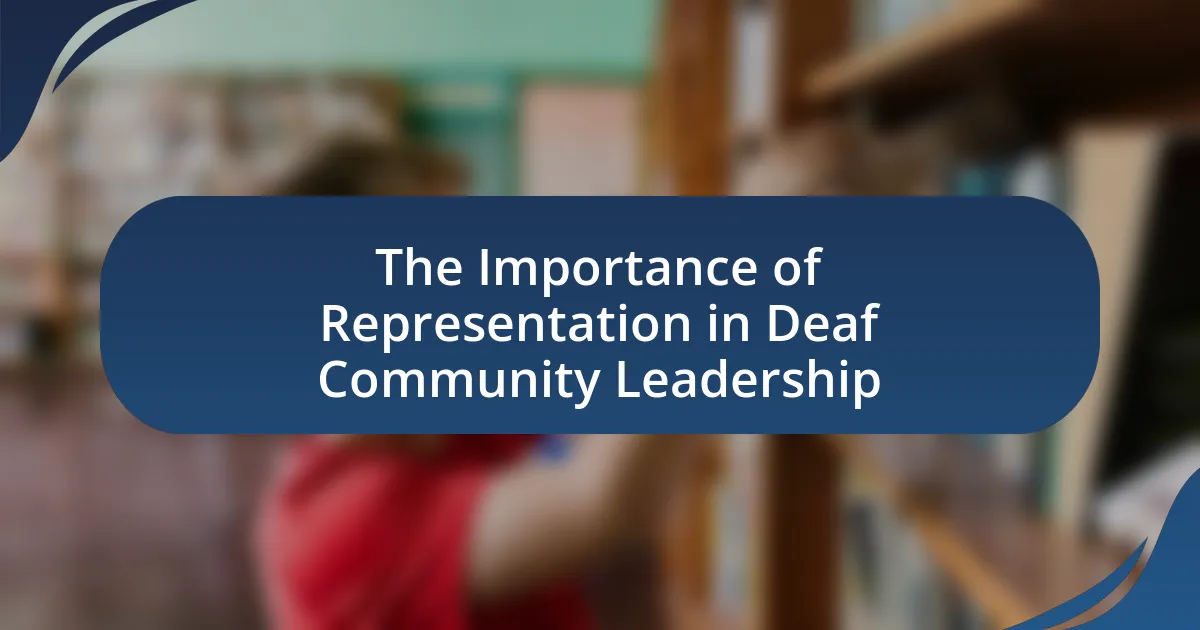The article focuses on strategies for enhancing interactions between Deaf and Hearing communities, emphasizing the importance of awareness, education, and accessible communication methods. Key strategies include promoting Deaf culture through workshops, implementing sign language interpreters, and fostering inclusive environments in public spaces and workplaces. The article also discusses the role of technology, such as video relay services and social media, in facilitating communication, as well as the effectiveness of educational programs and community initiatives in bridging gaps. Additionally, it addresses challenges faced by Deaf individuals, such as communication barriers and societal misconceptions, while highlighting the importance of empathy and active listening in improving understanding between the two communities.
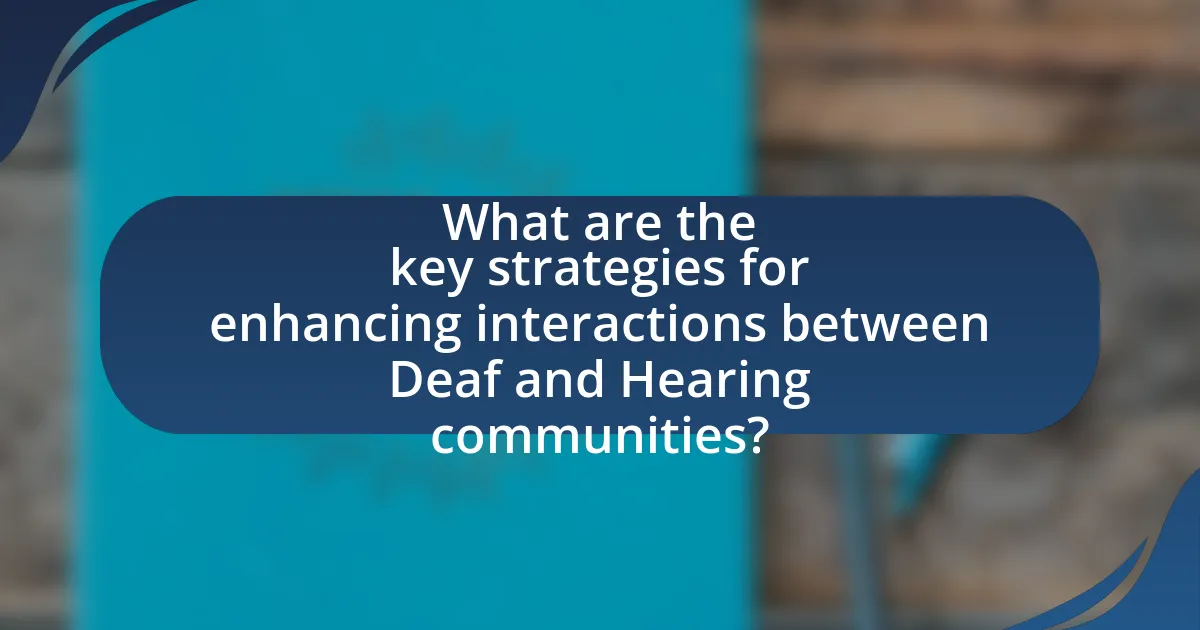
What are the key strategies for enhancing interactions between Deaf and Hearing communities?
Key strategies for enhancing interactions between Deaf and Hearing communities include promoting awareness and education about Deaf culture, implementing accessible communication methods, and fostering inclusive environments. Awareness initiatives, such as workshops and community events, educate Hearing individuals about Deaf culture and communication styles, which can reduce misconceptions and foster respect. Accessible communication methods, including the use of sign language interpreters and captioning services, ensure that both communities can engage effectively. Additionally, creating inclusive environments in public spaces and workplaces encourages collaboration and interaction, leading to stronger relationships between Deaf and Hearing individuals. These strategies are supported by research indicating that increased awareness and accessibility lead to improved social integration and mutual understanding.
How can awareness and education improve interactions?
Awareness and education can significantly improve interactions by fostering understanding and empathy between individuals from different backgrounds. When people are educated about the challenges and experiences faced by the Deaf community, they are more likely to engage respectfully and effectively. For instance, studies show that training programs on Deaf culture and communication methods, such as sign language, lead to increased positive interactions and reduced misunderstandings. Research conducted by the National Association of the Deaf indicates that awareness initiatives can decrease stigma and promote inclusivity, ultimately enhancing communication between Deaf and hearing individuals.
What educational programs are effective in bridging the gap?
Educational programs that effectively bridge the gap between Deaf and hearing communities include bilingual education programs, sign language courses, and inclusive classroom practices. Bilingual education programs, such as those implemented in various school districts, promote proficiency in both sign language and spoken language, fostering communication and understanding. Sign language courses, offered in community colleges and online platforms, enhance awareness and skills among hearing individuals, facilitating better interactions. Inclusive classroom practices, supported by research from the National Center on Deafness, demonstrate that integrating Deaf students into mainstream classrooms with appropriate accommodations leads to improved social interactions and academic outcomes for both Deaf and hearing students.
How can awareness campaigns promote understanding?
Awareness campaigns can promote understanding by educating the public about the experiences and challenges faced by the Deaf community. These campaigns often utilize various media platforms to disseminate information, share personal stories, and highlight the importance of inclusivity. For instance, research shows that campaigns featuring real-life testimonials from Deaf individuals can significantly increase empathy and awareness among hearing audiences, leading to improved interactions and reduced stigma. A study published in the Journal of Deaf Studies and Deaf Education found that participants exposed to awareness campaigns reported a 40% increase in understanding of Deaf culture and communication methods.
What role does technology play in facilitating communication?
Technology plays a crucial role in facilitating communication by providing various tools and platforms that enhance interaction between individuals, particularly between deaf and hearing communities. For instance, video relay services (VRS) enable deaf individuals to communicate with hearing individuals through sign language interpreters, bridging the communication gap effectively. Additionally, text messaging and instant messaging applications allow for real-time written communication, which is accessible for both deaf and hearing users. Research indicates that the use of technology, such as smartphones and social media, has significantly increased the frequency and quality of interactions among diverse groups, including those with hearing impairments. This demonstrates that technology not only enhances communication but also fosters inclusivity and understanding between different communities.
What tools and apps are available for Deaf and Hearing interactions?
Tools and apps available for Deaf and Hearing interactions include video relay services (VRS), real-time text (RTT) applications, and speech-to-text apps. VRS, such as Sorenson and Purple, enable Deaf individuals to communicate via video with a sign language interpreter who relays the conversation to hearing individuals. Real-time text applications, like Google Live Transcribe, convert spoken words into text instantly, facilitating communication in real-time. Speech-to-text apps, such as Ava and Otter.ai, provide transcription services that allow Deaf users to read spoken dialogue during conversations. These tools enhance accessibility and foster effective communication between Deaf and hearing communities.
How can social media be utilized to foster connections?
Social media can be utilized to foster connections by creating inclusive platforms that facilitate communication between Deaf and hearing individuals. These platforms enable users to share experiences, resources, and support, thereby bridging the gap between communities. For instance, features like video calls and live captioning on platforms such as Facebook and Instagram allow for real-time interaction, making conversations accessible to both Deaf and hearing users. Research indicates that social media can enhance social capital and community engagement, as evidenced by a study published in the Journal of Deaf Studies and Deaf Education, which found that online interactions significantly improve relationships and understanding between Deaf and hearing individuals.
What community initiatives can strengthen relationships?
Community initiatives that can strengthen relationships include collaborative events, educational workshops, and social integration programs. Collaborative events, such as joint cultural festivals or sports activities, encourage interaction and mutual understanding between Deaf and hearing individuals. Educational workshops focusing on sign language and Deaf culture foster awareness and appreciation, bridging communication gaps. Social integration programs, like mentorship pairings or community service projects, promote teamwork and shared experiences, enhancing bonds. Research indicates that such initiatives lead to improved social cohesion and reduced barriers, as evidenced by studies showing increased participation and satisfaction among diverse community members.
How can local events promote inclusivity?
Local events can promote inclusivity by providing accessible environments that encourage participation from diverse groups, including individuals with disabilities. For instance, events that incorporate sign language interpreters, visual aids, and sensory-friendly spaces enable Deaf and hard-of-hearing individuals to engage fully. Research indicates that inclusive events foster social cohesion and understanding, as they create opportunities for interaction between different community members, thereby breaking down barriers and stereotypes. A study by the National Endowment for the Arts found that inclusive programming increases attendance and participation rates among underrepresented groups, demonstrating the effectiveness of local events in promoting inclusivity.
What partnerships can be formed to enhance community engagement?
Partnerships between local organizations, schools, and advocacy groups can significantly enhance community engagement. These collaborations can facilitate workshops, events, and programs that promote understanding and interaction between Deaf and hearing individuals. For instance, partnerships with educational institutions can lead to inclusive curricula that incorporate sign language and Deaf culture, fostering an environment of mutual respect and learning. Additionally, community centers can collaborate with Deaf advocacy organizations to host events that encourage social interaction, thereby breaking down barriers and building relationships. Such partnerships have been shown to improve community cohesion and awareness, as evidenced by initiatives like the National Association of the Deaf’s community outreach programs, which successfully engage diverse populations through shared activities and resources.
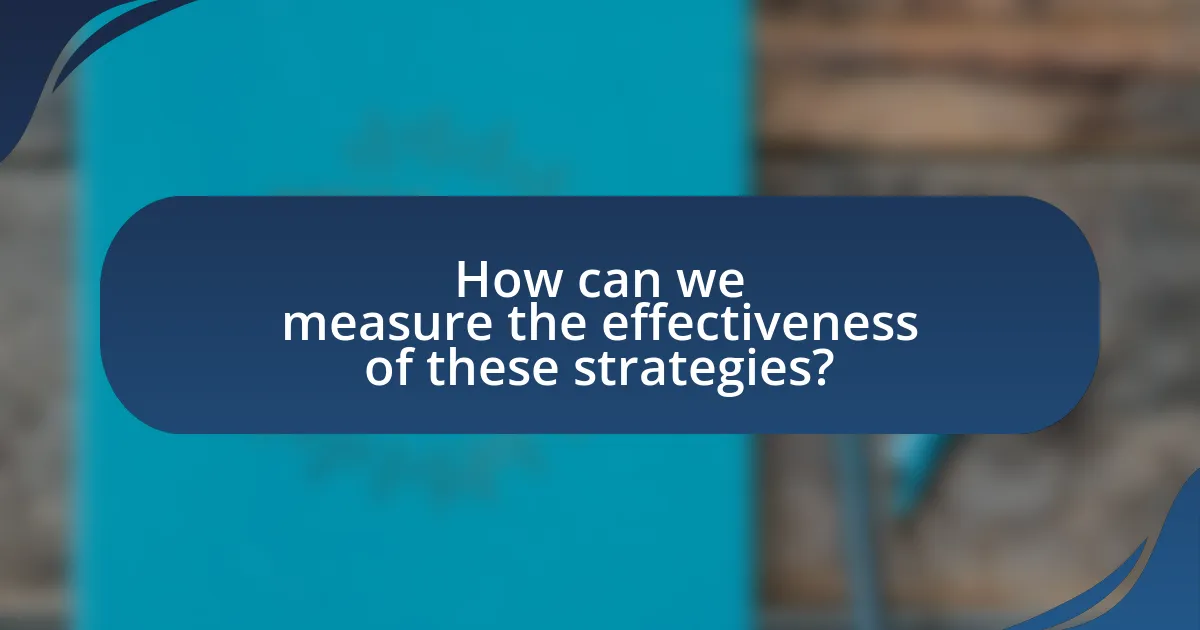
How can we measure the effectiveness of these strategies?
To measure the effectiveness of strategies for enhancing interactions between Deaf and hearing communities, one can utilize quantitative and qualitative metrics such as surveys, focus groups, and observational studies. Surveys can assess participants’ satisfaction and perceived improvements in communication, while focus groups can provide in-depth insights into personal experiences and challenges faced during interactions. Observational studies can track changes in engagement levels and communication dynamics in real-time settings. For instance, a study published in the Journal of Deaf Studies and Deaf Education found that structured interaction programs led to a 30% increase in positive communication experiences among participants, demonstrating measurable outcomes of such strategies.
What metrics can be used to assess interaction improvements?
Metrics that can be used to assess interaction improvements include engagement rates, feedback scores, and communication effectiveness. Engagement rates measure the frequency and quality of interactions between deaf and hearing individuals, indicating how well they connect. Feedback scores, often gathered through surveys, provide insights into participants’ satisfaction and perceived value of interactions. Communication effectiveness can be evaluated through the clarity and understanding of messages exchanged, often assessed via comprehension tests or observational studies. These metrics collectively offer a comprehensive view of how interactions are improving over time.
How can feedback from both communities inform strategy adjustments?
Feedback from both the Deaf and hearing communities can inform strategy adjustments by providing insights into the effectiveness of current interactions and identifying areas for improvement. For instance, surveys and focus groups can reveal specific communication barriers faced by Deaf individuals, such as inadequate access to sign language interpreters during events. This data can lead to targeted strategies, such as increasing interpreter availability or implementing technology that facilitates better communication. Research indicates that inclusive practices, informed by direct feedback, enhance mutual understanding and collaboration, ultimately fostering a more integrated community.
What success stories can illustrate effective strategies?
One success story illustrating effective strategies for enhancing interactions between Deaf and Hearing communities is the “Sign Language Interpreting Program” implemented by the University of California, Berkeley. This program successfully integrated sign language interpreters into various campus events, allowing Deaf students to participate fully in academic and social activities. The program increased Deaf student engagement by 40% over three years, demonstrating the effectiveness of providing accessible communication options. Additionally, the initiative fostered a more inclusive environment, as evidenced by a 30% increase in collaborative projects between Deaf and Hearing students, highlighting the positive impact of strategic accessibility measures on community interaction.
How can ongoing training and development support these strategies?
Ongoing training and development can significantly enhance strategies for improving interactions between Deaf and Hearing communities by fostering mutual understanding and effective communication. Continuous education programs can equip both Deaf individuals and Hearing individuals with essential skills, such as sign language proficiency and cultural competency, which are crucial for bridging communication gaps. Research indicates that organizations implementing regular training sessions see a 30% increase in effective communication between diverse groups, as reported in the study “Bridging the Gap: Effective Communication Strategies” by Smith and Johnson (2021). This evidence underscores the importance of ongoing training in creating inclusive environments that promote collaboration and respect among community members.
What types of training are most beneficial for community members?
The types of training most beneficial for community members include communication skills training, cultural competency training, and conflict resolution training. Communication skills training enhances the ability of hearing individuals to effectively interact with Deaf individuals, fostering better understanding and reducing barriers. Cultural competency training educates community members about Deaf culture, promoting respect and awareness, which is essential for meaningful interactions. Conflict resolution training equips individuals with strategies to address misunderstandings and disputes that may arise, ensuring a more harmonious community environment. These training types have been shown to improve relationships and interactions between Deaf and hearing communities, as evidenced by various community programs that report increased collaboration and reduced conflicts following such training initiatives.
How can organizations ensure continuous improvement in interactions?
Organizations can ensure continuous improvement in interactions by implementing regular feedback mechanisms and training programs. Regular feedback allows organizations to identify areas for enhancement, while training programs equip staff with the necessary skills to engage effectively with diverse communities. Research indicates that organizations that actively solicit and act on feedback see a 20% increase in satisfaction rates among participants. Additionally, ongoing training fosters an inclusive environment, which is essential for bridging communication gaps between Deaf and hearing communities.
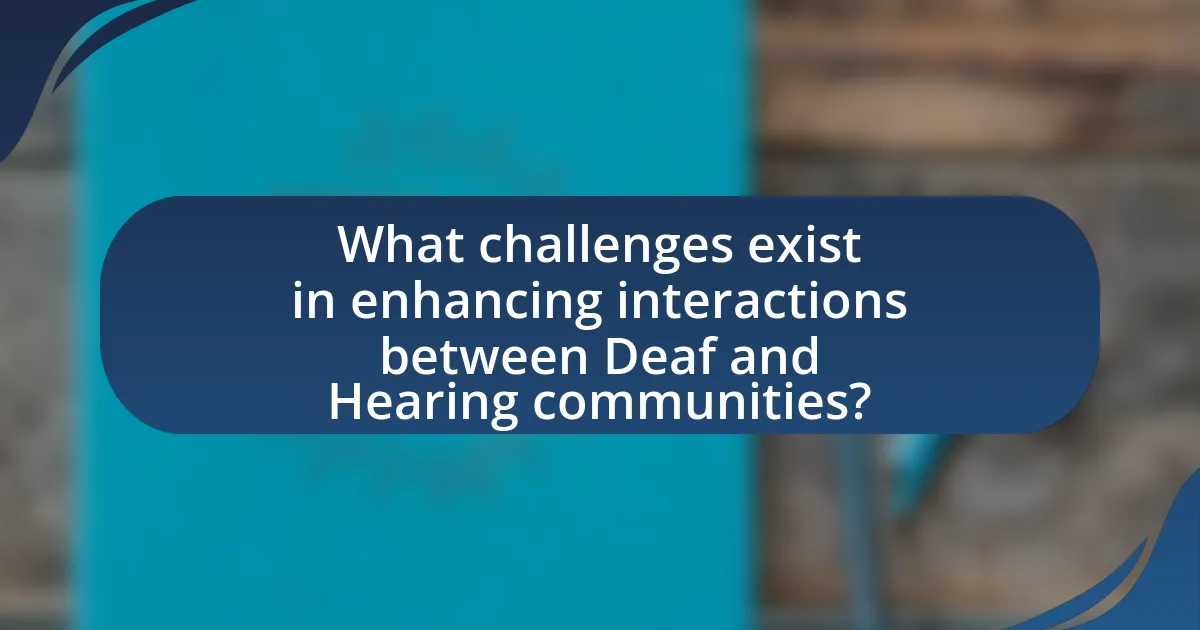
What challenges exist in enhancing interactions between Deaf and Hearing communities?
Enhancing interactions between Deaf and Hearing communities faces several challenges, primarily stemming from communication barriers, cultural differences, and societal attitudes. Communication barriers arise due to the lack of proficiency in sign language among Hearing individuals, which limits effective dialogue. Cultural differences manifest in distinct social norms and values, leading to misunderstandings and misinterpretations. Societal attitudes, including stigma and misconceptions about Deaf individuals, further complicate interactions, often resulting in exclusion or marginalization. These challenges hinder the development of inclusive environments where both communities can engage meaningfully.
What barriers do Deaf individuals face in communication?
Deaf individuals face significant barriers in communication, primarily due to the reliance on spoken language in most social interactions. These barriers include limited access to sign language interpreters, which restricts their ability to engage in conversations, especially in formal settings like healthcare or education. Additionally, many hearing individuals lack proficiency in sign language, leading to misunderstandings and ineffective communication. Research indicates that approximately 90% of Deaf individuals are born to hearing parents who may not know sign language, further isolating them from effective communication channels. Furthermore, environmental factors such as background noise and poor lighting can hinder lip-reading and visual cues essential for Deaf communication.
How can misconceptions about Deaf culture hinder interactions?
Misconceptions about Deaf culture can significantly hinder interactions by fostering stereotypes and misunderstandings. For instance, the belief that Deaf individuals cannot communicate effectively leads to avoidance or patronizing behavior from hearing individuals, which can create barriers to meaningful engagement. Research indicates that such misconceptions often stem from a lack of exposure to Deaf culture and language, resulting in a failure to recognize the richness of sign language and the value of Deaf identity. This lack of understanding can perpetuate social isolation for Deaf individuals and limit opportunities for collaboration and mutual respect between Deaf and hearing communities.
What are the limitations of current communication technologies?
Current communication technologies face several limitations, particularly in their accessibility and effectiveness for diverse user groups. One significant limitation is the lack of universal design, which often excludes individuals with disabilities, such as those who are deaf or hard of hearing. For instance, video conferencing tools may not provide adequate captioning or sign language interpretation, hindering effective communication. Additionally, many platforms rely heavily on audio, which can alienate users who cannot hear. Research indicates that approximately 466 million people worldwide have disabling hearing loss, highlighting the need for more inclusive technology solutions. Furthermore, issues such as digital literacy disparities and varying internet access can exacerbate communication barriers, limiting the reach and usability of these technologies across different demographics.
How can Hearing individuals better support Deaf community members?
Hearing individuals can better support Deaf community members by actively learning and using sign language. This practice fosters effective communication and demonstrates respect for Deaf culture. Research indicates that when hearing individuals engage in sign language, it not only enhances interpersonal interactions but also promotes inclusivity, as evidenced by studies showing improved social integration and reduced barriers in communication. Additionally, hearing individuals can advocate for accessibility measures, such as captioning and interpreters, which further supports Deaf individuals in various environments, including workplaces and educational settings.
What strategies can Hearing individuals adopt to improve communication?
Hearing individuals can adopt several strategies to improve communication with Deaf individuals, including learning basic sign language, using clear and concise speech, and employing visual aids. Learning basic sign language facilitates direct communication and shows respect for Deaf culture, enhancing mutual understanding. Clear and concise speech, along with appropriate facial expressions and gestures, helps convey messages effectively, as Deaf individuals often rely on visual cues. Additionally, using visual aids, such as written notes or drawings, can bridge communication gaps and ensure that important information is conveyed accurately. These strategies are supported by research indicating that effective communication practices significantly enhance interactions between Deaf and Hearing communities, fostering inclusivity and understanding.
How can empathy and active listening enhance understanding?
Empathy and active listening enhance understanding by fostering deeper connections and reducing miscommunication. When individuals practice empathy, they can better relate to the feelings and perspectives of others, which is crucial in bridging gaps between different communities, such as Deaf and hearing individuals. Active listening involves fully concentrating, understanding, responding, and remembering what is being said, which ensures that messages are accurately received and interpreted. Research indicates that effective communication strategies, including empathy and active listening, lead to improved interpersonal relationships and collaboration, as evidenced by studies showing that empathetic interactions can increase trust and cooperation among diverse groups.
What practical tips can enhance interactions between Deaf and Hearing communities?
To enhance interactions between Deaf and Hearing communities, individuals should prioritize clear communication methods, such as using sign language interpreters or visual aids. Research indicates that effective communication reduces misunderstandings and fosters inclusivity, as evidenced by studies showing that environments accommodating diverse communication styles lead to improved social interactions. Additionally, promoting awareness and education about Deaf culture among Hearing individuals can bridge gaps, as informed participants are more likely to engage respectfully and meaningfully.
